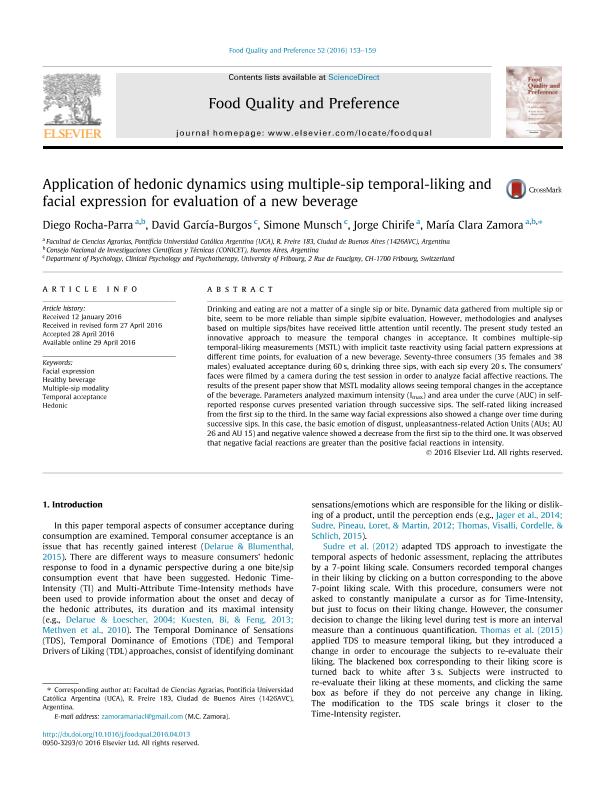Mostrar el registro sencillo del ítem
dc.contributor.author
Rocha Parra, Diego Fernando

dc.contributor.author
García Burgos, David
dc.contributor.author
Munsch, Simone
dc.contributor.author
Chirife, Jorge

dc.contributor.author
Zamora, María Clara

dc.date.available
2018-04-18T18:46:23Z
dc.date.issued
2016-09
dc.identifier.citation
Rocha Parra, Diego Fernando; García Burgos, David; Munsch, Simone; Chirife, Jorge; Zamora, María Clara; Application of hedonic dynamics using multiple-sip temporal-liking and facial expression for evaluation of a new beverage; Elsevier; Food Quality and Preference; 52; 9-2016; 153-159
dc.identifier.issn
0950-3293
dc.identifier.uri
http://hdl.handle.net/11336/42525
dc.description.abstract
Drinking and eating are not a matter of a single sip or bite. Dynamic data gathered from multiple sip or bite, seem to be more reliable than simple sip/bite evaluation. However, methodologies and analyses based on multiple sips/bites have received little attention until recently. The present study tested an innovative approach to measure the temporal changes in acceptance. It combines multiple-sip temporal-liking measurements (MSTL) with implicit taste reactivity using facial pattern expressions at different time points, for evaluation of a new beverage. Seventy-three consumers (35 females and 38 males) evaluated acceptance during 60 s, drinking three sips, with each sip every 20 s. The consumers’ faces were filmed by a camera during the test session in order to analyze facial affective reactions. The results of the present paper show that MSTL modality allows seeing temporal changes in the acceptance of the beverage. Parameters analyzed maximum intensity (Imax) and area under the curve (AUC) in self-reported response curves presented variation through successive sips. The self-rated liking increased from the first sip to the third. In the same way facial expressions also showed a change over time during successive sips. In this case, the basic emotion of disgust, unpleasantness-related Action Units (AUs; AU 26 and AU 15) and negative valence showed a decrease from the first sip to the third one. It was observed that negative facial reactions are greater than the positive facial reactions in intensity.
dc.format
application/pdf
dc.language.iso
eng
dc.publisher
Elsevier

dc.rights
info:eu-repo/semantics/openAccess
dc.rights.uri
https://creativecommons.org/licenses/by-nc-sa/2.5/ar/
dc.subject
Facial Expression
dc.subject
Healthy Beverage
dc.subject
Multiple-Sip Modality
dc.subject
Temporal Acceptance
dc.subject.classification
Alimentos y Bebidas

dc.subject.classification
Otras Ingenierías y Tecnologías

dc.subject.classification
INGENIERÍAS Y TECNOLOGÍAS

dc.title
Application of hedonic dynamics using multiple-sip temporal-liking and facial expression for evaluation of a new beverage
dc.type
info:eu-repo/semantics/article
dc.type
info:ar-repo/semantics/artículo
dc.type
info:eu-repo/semantics/publishedVersion
dc.date.updated
2018-04-17T19:58:07Z
dc.journal.volume
52
dc.journal.pagination
153-159
dc.journal.pais
Países Bajos

dc.journal.ciudad
Amsterdam
dc.description.fil
Fil: Rocha Parra, Diego Fernando. Consejo Nacional de Investigaciones Científicas y Técnicas; Argentina. Pontificia Universidad Católica Argentina "Santa María de los Buenos Aires"; Argentina
dc.description.fil
Fil: García Burgos, David. University of Fribourg; Suiza
dc.description.fil
Fil: Munsch, Simone. University of Fribourg; Suiza
dc.description.fil
Fil: Chirife, Jorge. Pontificia Universidad Católica Argentina "Santa María de los Buenos Aires"; Argentina
dc.description.fil
Fil: Zamora, María Clara. Consejo Nacional de Investigaciones Científicas y Técnicas; Argentina. Pontificia Universidad Católica Argentina "Santa María de los Buenos Aires"; Argentina
dc.journal.title
Food Quality and Preference

dc.relation.alternativeid
info:eu-repo/semantics/altIdentifier/doi/http://doi.org/10.1016/j.foodqual.2016.04.013
dc.relation.alternativeid
info:eu-repo/semantics/altIdentifier/url/https://www.sciencedirect.com/science/article/pii/S0950329316300854
Archivos asociados
